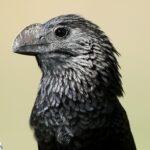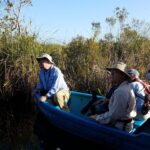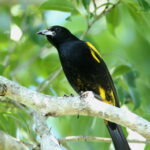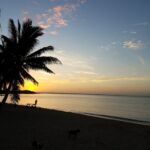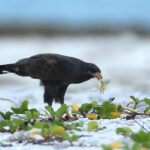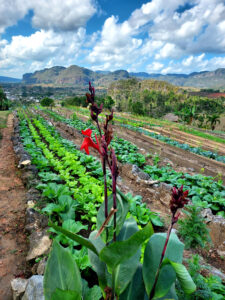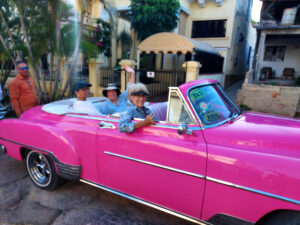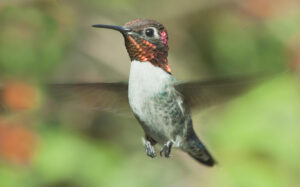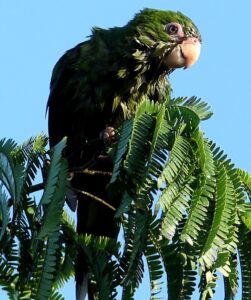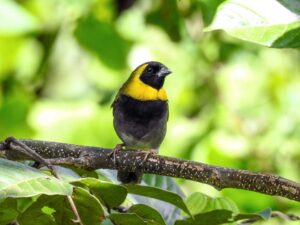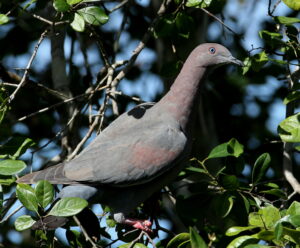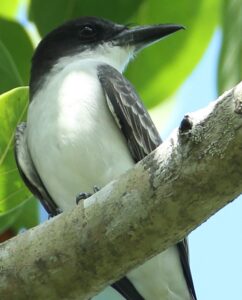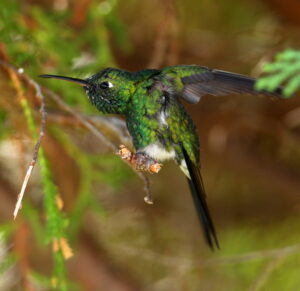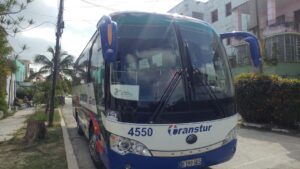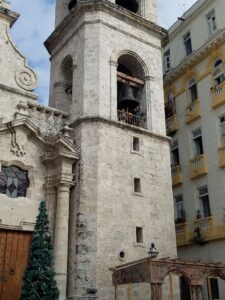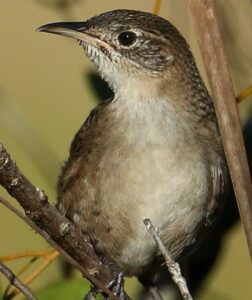Cuba Birding & Natural History
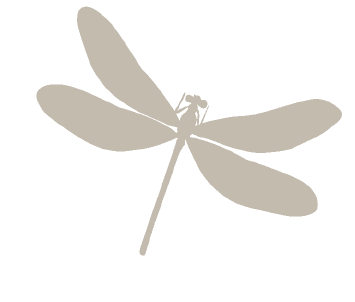
Western Mountains, Zapata Peninsula, and Havana
Two departures:
March 13 - 22, 2025
February 6 -15, 2025
$4,750 | ($500 deposit due upon registration)
Single Supplement: $425
10 participants max
T
his adventure blends birding with in-depth exploration of a wide range of Cuban fauna, flora, ecology, and history. We will learn from Cuban experts about the birds, reptiles, amphibians, mammals, invertebrates, and the ecosystem interactions between them. We will even have opportunities to snorkel safely among some of Cuba’s marine life. We will discuss the main issues surrounding conservation in the Cuban Archipelago, and learn from our in-country guides about local history, politics, education, health care, housing, transportation, and daily life.
Our program begins in Havana, where we’ll be first introduced to Cuba’s amazing, rich biodiversity, including its strikingly high degree of endemic organisms. Once outside of Havana, we will explore two very distinct geographic regions of the country chosen for their diverse ecological systems and natural beauty: Cuba’s Western Mountains include submontane seasonal rain forests, pine forests, and tropical karstic forests. We will visit the magical and beautiful karstic landscape of mogotes-- the towering, lushly vegetated, flat-top limestone monoliths that dominate the Organos Mountains. We will then explore the diverse wetland region of the Zapata Peninsula, Cuba’s richest and most important birding destination located in the historic Bay of Pigs. The peninsula covers more than 2800 square miles and features easily accessible, everglades-like ecology and habitat. Framed by the pristine Caribbean coastal environment of the Bay of Pigs, the peninsula comprises vast open swampland, low coastal forests, sparkling white sand beaches, healthy and accessible coral reefs, and refreshing natural limestone pools called cenotes.
Finally, we’ll return to Havana for a walking tour of Habana Vieja (Old Havana), the city’s historic colonial center, which was declared a UNESCO World Heritage site in 1987. Havana abounds with historic sites, diverse architecture, museums, art galleries that underscore a cultural heritage and recently resurgent energy and verve that is uniquely Cuban.
Additional Information
(Click each tab to expand)
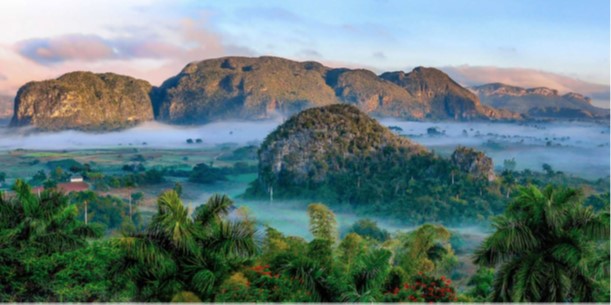
This program offers opportunities for several days of casual birding, with some early departure times and evening sessions. Birding days may provide leisure time after lunch and before our afternoon excursions. Physical exertion will be light to moderate on most days, with the longest walks approximately 2.5 miles. Terrain is mostly flat and dry, except for the Western Mountains, where we will encounter some walking up hills. Be prepared for strong sun, with temperatures in the mid 70s – 80s during winter, and into the 90s in spring and summer months. Mosquitoes can be bothersome in the Zapata Region. Rain can be expected from time to time throughout the trip, though this trip takes place in the dry season.
Clothing: Pack light field clothing of neutral colors. Bring several pairs of long pants and comfortable, light, airy shirts. Long-sleeved (relaxed fit) shirts are useful for protection from the sun, as is a light hat or cap. Be sure to have a pair of comfortable walking shoes or hiking boots, plus a second pair of tennis shoes or sandals. A fleece, a hat, and gloves are important for our visit to higher elevation areas where it can be quite chilly. You may want more casual clothing for traveling or dinners. A small washcloth and handkerchiefs will be helpful.
Equipment: Bring a pair of binoculars, a field guide, and a camera with extra batteries. The guides will have spotting scopes. Pack sunglasses and sunscreen, a small flashlight or headlamp, a small alarm clock (a smartphone will work), insect repellent, a small daypack, and a small folding stool if you get tired standing for long periods observing birds and other wildlife.
Chip Darmstadt, Birding Ambassador and "emeritus" executive director of North Branch Nature Center, is an avid neotropical birder and naturalist. Chip has guided birding trips around the US and around the world for nearly 25 years, observing over 2,300 bird species along the way.
NBNC’s partners for this trip, The Caribbean Conservation Trust (CCT), offer exclusive, US-managed birding and natural history excursions in Cuba. These programs are coordinated under U.S. government authorization through Connecticut-based CCT, which is proud of its 27 year history managing bird conservation natural history programs in Cuba. In addition to CCT Founder and Executive Director Gary Markowski, our team will include esteemed Cuban biologist Dr. Giraldo Alayon or Nils Navarro) and local naturalists who are experts in their respective geographic regions of Cuba.
Dr. Giraldo Alayon (March Trip) is well known in the Caribbean as the foremost expert on spiders of the West Indies and Central America. He has published more than 100 papers on the systematics and biogeography of spiders and other insects in the region. Giraldo has been birding seriously since 1977, and has also published 15 papers related to avian biology and behavior. He is currently working on a book about the Ivory–billed Woodpecker, which he claims to have seen in eastern Cuba in 1992. Dr. Alayon has traveled to various island nations in the Lesser Antilles, and has made many trips to the United States with grants from the American Museum of Natural History; Smithsonian Institution; Museum of Comparative Zoology (Harvard University); Field Museum; Philadelphia Academy of Natural Sciences; Peabody Museum (Yale University); Museum of Zoology, University of Michigan (Ann Arbor); and California Academy of Sciences. From 1995 to 2001, Dr. Alayon was president of the Cuban Zoological Society. He is currently curator of Arachnida at the National Museum of Natural History at Havana, where he has worked since 1988.
The U.S. Department of Treasury has provided a license for conducting bird and habitat conservation work in Cuba to the Caribbean Conservation Trust, Inc. (CCT), a U.S. based organization committed to the conservation of endemic and migratory birds and their habitats in the greater Caribbean region. The primary objective of CCT is to enhance the ability of North American and Caribbean ornithologists, naturalists, resource managers, conservation organizations, institutions, and local citizens to conduct research and initiate programs to help conserve the birds of the Caribbean and their habitats. CCT is dedicated to bird and habitat conservation through education and relationship building and is in compliance with U.S. Treasury licensure for travel to Cuba. CCT’s license also authorizes the examination of a wide range of environmental topics related to Cuban conservation and natural history.
Accommodations feature hotels and tourist board-approved stays in privately owned B&Bs in Havana and 3 additional provinces. Our Cuban accommodations are staffed by friendly, helpful hosts and represent the best Cuba has to offer in the regions we visit, and may include refurbished vintage 4 star hotels and private villas, modest 3 star facilities, and simple beach-front bungalows. All accommodations are safe, clean, air conditioned tourist facilities. It should be noted that standards in Cuba differ from those in the U.S. and other developed countries, but we strive for clean, comfortable, and friendly lodging everywhere we stay.
The trip cost includes:
- Pre-departure orientation gathering (virtual).
- Two expert guides.
- All food and accommodations in Cuba.
- Entrance fees to parks and tours.
- All ground transportation and drivers.
- Gratuities for in-country support (drivers, restaurants, etc.).
- A donation to CCT for conservation efforts in Cuba.
- Carbon offsets for all airfare and travel to, from, and during this trip.
The trip cost does not include:
- Airfare to/from Florida and Florida to/from Cuba.
- Cuban Visa (about $90).
- Lodging and food in Florida.
- Travel insurance.
- Alcoholic beverages, snacks and other incidentals.
- Bar and housekeeping gratuities.
- Lead guide gratuities.
NBNC is proud to announce that all of our trips from 2025 onward are 100% carbon-neutral. This includes each traveler's flights to and from this destination, as well as carbon emitted during the trip.
How it Works: The voluntary carbon market has come under intense scrutiny in recent years as the legitimacy and effectiveness of many carbon offsetting projects have been called into question. That's why we're proud to be working directly with the Northeast Wilderness Trust's Wild Carbon program. The carbon credits we purchase to offset our carbon emissions are used to permanently conserve forestland as wilderness. Why wilderness offsets?
- It's Permanent: Unlike most contracts in the voluntary carbon market that have a lifespan of just 10-20 years, wilderness conservation is forever.
- It's Additive: Acreage purchased and conserved through wild carbon offsets would not be protected anyway through another mechanism later.
- It's "Leakproof:" Forest protection often just shifts and concentrates timber harvest elsewhere. But wilderness conservation is different–wilderness protection here doesn't just move carbon emission over there. That's because old forests function very differently than young ones. Big trees and old soils capture and store vastly more carbon than a young forest of the same acreage. Growing an old forest is like building a natural carbon sequestration factory!
- It's More than Carbon: With wilderness protection comes additional co-benefits like biodiversity conservation, flood resilience, and habitat connectivity. This way, going carbon-neutral isn't just negating our carbon footprint, it's also actively helping conservation in other ways.
Want to learn more?:
- Read The Ecotourism Dilemma our article on how we think about carbon emissions in the context of nature travel.
- Check out this FAQ for NBNC travelers about Northeast Wilderness Trust's Wild Carbon Program.
- To learn more about forest carbon storage, please watch Understanding Forest Carbon by climate forester Dr. Ali Kosiba.
Ready to go to Cuba?
Email [email protected] to get signed up.
Payment Schedule
- A $500 deposit is required to reserve your space on the trip.
- 50% of the trip balance will be due 6 months before the departure date.
- The remaining trip balance will be due 3 months before the departure date.
All payments can be made via ACH withdrawal, or by check. Credit card payments will incur a 3% surcharge.
Cancellation Policies
We understand that incidents and emergencies arise that may force you to cancel your trip. However, NBNC invests considerable time and, in many cases, non-refundable payments to lodges and local contractors to secure our rooms and programming. NBNC aims to be as flexible as possible in our refund policy, but a full refund of your payments may not be possible after the dates indicated. All cancellations must be made via email to NBNC.
-
Cancellation more than 180 days before the trip: Full refund of all payments.
-
Cancellation 90-180 days before the trip: Refund of any payments minus the $500 deposit. If your space is filled by another traveler, we will also refund your deposit.
-
Cancellation 30-90 days before the trip: No refund guaranteed. If your space is filled by another traveler, we will provide a full refund minus the $500 deposit.
-
Cancellation less than 30 days before the trip: No refunds guaranteed.
We highly recommend purchasing private travel insurance to cover expenses that are outside of NBNC's cancellation and refund policies.
Day by Day Itinerary
Day "0" (March 13 or February 6): Arrivals in Florida
Travelers will arrive in Florida at their leisure anytime today, so that the trip is ready to commence the next morning. Due to US/Cuba travel restrictions, the group must fly together from Florida to Cuba in a single group the following day. Travelers are responsible for arranging their own flights and lodging today, but your guides will be in touch to coordinate all flight itineraries and visas as the trip approaches.
Day 1: U.S. to Havana, transfer to Vinales National Park
We will aim to arrive in Havana late in the morning from south Florida and travel to Vinales Valley (2.5 hours) in the heart of Cuba’s renowned tobacco growing region. This enchanting valley is surrounded by lushly vegetated ‘mogotes’, or blunt, ragged limestone monoliths that dominate the region. We will visit one of the many accessible caves and hiking trails within the national park. Endemic birds such as Cuban Tody, Cuban Green Woodpecker, Yellow-headed Warbler, Cuban Trogon, Cuban Pygmy-Owl and Great Lizard Cuckoo will be among the birds we pursue in this region over the next couple of days. Optional evening visit to the mouth of a local cave to witness the exit of thousands of endemic and regionally endemic bats. Dinner at an excellent private restaurant. Accommodation in Vinales (2 nights).
Day 2: Vinales National Park
Morning birding and easy walking among the mogotes along lush, karstic trails. We will visit Santo Tomas (30 minutes) to explore an impressive local cave system which spans several levels, staying on safe paths with a local naturalist. The endemic Cuban Solitaire with it’s flute-like song may be seen here. We will also visit a small tobacco plantation and enjoy lunch at an organic farm / restaurant with tremendous views of the valley. Our afternoon concludes with a visit to the private home and art studio of Nils Navarro - Cuba's best wildlife artist and author of the Field Guide to Endemic Birds of Cuba.
Day 3: Vinales - Las Terrazas - Soroa
Early birding option, breakfast and departure east ( 90 minutes) to Las Terrazas nestled in native pine forest and submontane seasonal rain forest habitat. ‘The Terraces’ was established in the 1960s as an environmental recovery project that has succeeded as a model eco-friendly sustainable community. We will explore trails in the surrounding hills, and visit with local naturalists here. Lunch is at Cafeta Buena Vista, a restored 19th century coffee plantation, offering sweeping views of the mountains, plains and coast. Afterwards we will depart for Soroa (45 minutes) and the Sierra de la Rosario Biosphere Reserve. Upon arrival we will visit the orchidarium at Soroa. Managed by the University of Pina del Rio, the gardens cover over 7 acres perched on a steep hillside surrounded by mountains and lush forest. More than 700 species of orchid, in addition to numerous other native plants and exotic species from around the globe can be found here with the help of a resident botanist. Dinner and accommodation at Villa Soroa (1 night).
Day 4: Soroa to Zapata Peninsula
Breakfast, with optional birding in the nearby forest, with a hike (2.5 miles total) to the top of El Mirador, with excellent views of the surrounding mountains and Caribbean coast. Lunch followed by departure to Zapata Swamp National Park and Bay of Pigs (4 hours). This region contains the largest wetland complex in the West Indies, and is Cuba’s most prolific birding region, hosting. The peninsula has more than 900 species of flora, and more than 100 species of birds recorded. Dinner and accommodation at private homestays on or very near the beach in Playa Larga (3 nights).
Day 5: Zapata Peninsula
Morning birding in the forests around Bermejas Wildlife Refuge, where we will set sights on birds such as the endemic Blue-headed and Grey-fronted Quail Doves, Cuban Parakeet, Fernandina’s Flicker, Cuban Bare-legged Owl, and the world’s smallest bird, the Bee Hummingbird. Many other bird species are likely here. Late morning visit to the Giron Museum, commemorating the Bay of Pigs invasion. Lunch and snorkeling options at Caleta Buena, a gorgeous, protected natural inlet abundant with sea life. Certified divers have diving options here. Return to our hotel for an afternoon break. Afternoon visit to a nearby crocodile breeding center. Dinner, lodging in Playa Larga.
Day 6: Zapata
Morning visit to Las Salinas reserve for birding in forest, mangrove, and open salt flat habitat. Endemic Cuban Blackhawk, a resident sub species of Yellow Warbler, and a variety of wading birds such as American Flamingo, Wood Stork, White Ibis, Roseate Spoonbill, and several heron species may be present. Lunch will be at a small restaurant in the forest featuring a cenote – a natural fresh water / saltwater pool for snorkeling or diving. This area is along the coast so there are opportunities to explore the nearby reef as well. We will also visit with local residents who have cultivated a backyard habitat to attract various bird species, including the Bee Hummingbird. Dinner, lodging in Playa Larga.
Day 7: Zapata – Havana
After breakfast we will pack up and head towards Havana. En route we will visit a Cuban parrot restoration project. After lunch we return to Havana and visit el Morro fortress overlooking the coastal entrance to the city. Initially built in 1589 in response to raids on Havana harbor, el Morro protected the mouth of the harbor with a chain being strung out across the water to the fort at La Punta. This sprawling complex offers splendid views of Old Havana and the Florida Straits. There are impressive walls, moats, draw bridges and courtyards, a four story former military barracks as well as a variety of interesting museum exhibits dating from the 16th century. Dinner at a private restaurant, accommodation in Havana.
Day 8: Havana
Today our half-day walking tour will include a guided interpretive exploration of some of colonial Havana’s most significant historical sites. This UNESCO World Heritage site is loaded with a variety of museums, a thriving arts scene, and a full range of architectural examples of both renovated and neglected structures, many opulent or otherwise unique, representing 5 centuries of human habitation. We will have lunch and dinner in two of Old Havana’s best private restaurants. Late afternoon is open for exploration of this fascinating and historic small city. Accommodation in Havana.
Day 9: Return to the U.S.
Breakfast followed by transfer from our hotel to Jose Marti Airport for the return flight to the U.S.
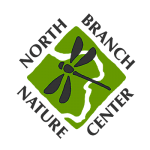
713 Elm Street
Montpelier, Vermont 05602
(802) 229-6206
Hours: Center Open Monday-Friday 9-4
Trails Open 24/7

